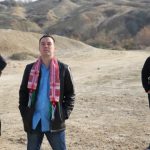Last summer, the Indigitous Serve cohort in the United States worked with a church in Los Angeles, California for the creation of a booklet called “Who Are Frontier People Groups?” The booklet is an illustrated prayer guide that features 31 different unreached people groups, each group brought to life with an animated character, a short story about that character, information about the progress of the Gospel in that group, and how to pray for them.
College students from the L.A. church volunteered by researching and designing those characters as well as writing the short stories. Those who worked on the project had different skill levels but all found a way to use their talents for God.
“I had so many uncertainties going into the project because everyone else had an art background. I did art for fun and never saw myself doing anything more professional with this hobby,” says Jessica, a graduate student at Azusa Pacific University.
Ben Tong, a character designer for DreamWorks TV, served as art director and mentor for the project. At first, he felt frustrated because the volunteers didn’t all have the same skill level or training. But as the project went on, he learned to embrace flexibility, to tailor the project to the level of the students, and try not to control everything. He helped everyone find their own style instead of trying to fit his own designs.
“In the end, I saw that God was teaching me to let go of my own sense of control in this project. My idea of ‘perfection’ in each design was not the priority. Instead, the results were up to Him,” Ben says.
Lives changed through design work
“I’m truly thankful to God for working in each of our lives and bringing us together to work on this project,” says Becky, an art student at ArtCenter College of Design.
For Becky, working on the Frontier People Groups booklet allowed her to use her talents in a meaningful way, but it was much more than that. Working with the Indigitous Cohort also impacted her own life. “God surprised me throughout these weeks. He grew my empathy for His people and allowed my heart to feel for them the way He felt for them,” she says. “There are so many people who don’t know the love of God, but God sent his son Jesus for them too.”
Samuel, an art student at Loyola Marymount University, experienced God opening his eyes and his heart to frontier people groups. It gave him a greater understanding and empathy.
“Researching these people groups and their customs, foods, festivals, and city names has opened up my eyes to God’s work. There were many places I can now find on a map,” Samuel says. “At a time when real-life travel was still off the table, the ability to purposefully pray over people across the world made all the work worth it.”

A new way to do missions
None of the college students had ever considered doing design or storytelling for the Church. None had thought their talents had anything to do with missionary work, but joining the Indigitous Serve cohort opened their eyes to a new way to do missions.
Jessica had gone on many short-term mission trips with her church in the past, but the pandemic made that impossible. When she heard about the Indigitous project, she was intrigued. “This project changed the way I view missions as a whole,” she says.
Jessica pursued education because she wanted to do something teaching-related for missions. It had never occurred to her that design could be a way of contributing to God’s work. “You don’t have to go across the country or world to engage with missions,” Jessica says. “God chose to take a hobby of mine that started up again during quarantine and use it for this mission project.”
Whitney, an art student at Azusa Pacific University, found the experience similarly eye-opening. “It became something much more than I anticipated,” she says. “Most of us on the team weren’t sure something like this could ever happen: using our creative and artistic skills for missions, but it did!”
Mentoring the students allowed Ben to not only use his design talent for God, but also to help introduce the students to this new way of thinking about mission work. “My experience working in the animation industry and now repurposing it for a digital missions project has been all God’s grace,” Ben says. “He was the one to inspire us, redeem our gifts, past experiences, and secular skills to be engaged in missions.”
Look for opportunities to serve
God has made each of us unique, with our own talents, interests, and passions. Within that unique design that makes us who we are are ways to leverage it in a meaningful way. For some, like Ben, it’s using professional skills to train and mentor others. For some, like Becky, Samuel, and Whitney, it’s finding meaningful work that applies the skills they’re learning. For others, like Jessica, it could involve a favorite hobby.
Whatever it is, pray for God to provide opportunities and open your eyes to them. When you see opportunities to serve God in a way that fits how He designed you, you won’t regret it.
“Whatever gifts and talents, interests, and serving capacity you have, God can always use you in ways that are only known by Him,” Whitney says.
Jessica has similar encouragement. “Whether it be a hobby or vocation or even an interest, be open to the opportunities God presents you,” she says. “Who knows how He can use it to bless those around you and further His kingdom!”

